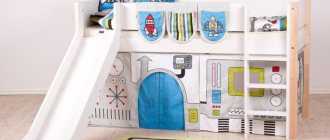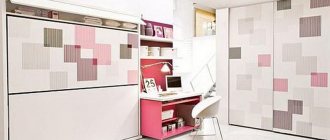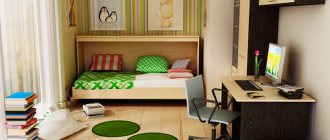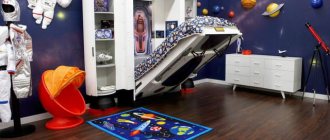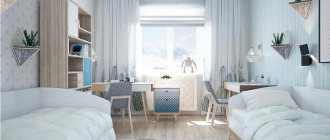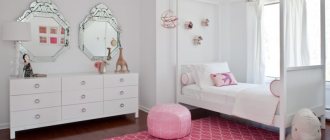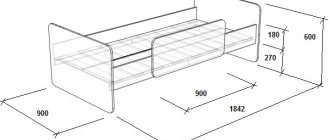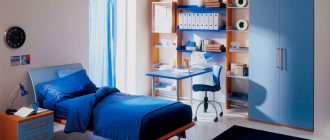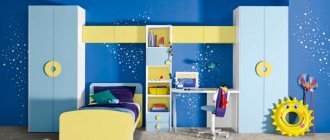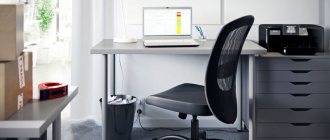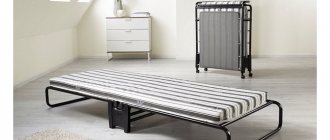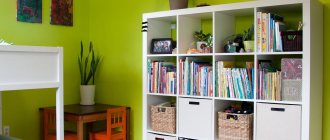<
>
The birth of a child is one of the most important events in the life of every family. Even before the baby’s first appearance in the house, future parents should take care of creating comfortable living conditions for the child and, first of all, purchase a cozy bed for the newborn.
What are the sizes of children's beds?
Different, from 120 cm in length, and further, in increments of 10 cm. It is the length that is the most important parameter here, since children are constantly growing. Consider this point when planning your budget. Below are approximate numbers.
- For children under 2 years old - 120 x 60 cm;
- up to 3 years - 140 x 70 cm;
- up to 5 years - 150 x 70 cm;
- up to 7 years - 160 x 80 cm;
- up to 10 years - 170 x 80 cm.
To determine which size is right for your child, take into account their current height. Add 40 cm to this figure if you plan to change the bed in 2-3 years. If you want to take a model “for growth,” add 70 cm. It can already be used for 5-7 years.
Additional equipment for cots for newborns
The cribs can be equipped with other pieces of furniture necessary to care for the baby. The furniture set may include:
- changing table;
- linen boxes;
- dresser;
- shelves;
- cabinet.
Additional accessories include a protective net or canopy. The canopy protects the baby from sunlight and insects.
A useful functional addition to a bed for newborns is the ability to adjust the level of the bottom and the auto-wall (lowering side wall of the crib).
What material is better for a children's bed?
These days, bed frames are made from a variety of materials, from MDF to solid wood, modern metal and even plastic. Each material offers something different, from greater durability to unique designs. But kids need furniture that will stand the test of time. Parts must be easy to clean and withstand heavy use. Of course, the best option would be natural wood. This is the most recommended material for making children's furniture. Here are its main advantages.
- Natural wood - strength, durability and environmental friendliness.
Important!
We would like to draw your attention to the fact that all children's furniture is subject to mandatory certification, is made from safe materials and meets all quality standards.
How to choose the right bed for a newborn
In the first months of life, a baby sleeps up to 20 hours a day, so for the harmonious development of a little person, it is important to properly organize the sleeping area. The furniture industry offers a huge selection of cribs for infants; the key criterion is the safety of the sleeping bed.
Experts recommend purchasing a crib at least two weeks before the birth of your long-awaited baby. The main reason for the presence of a specific smell in new furniture. To get rid of the smell, unpack the products and leave them in a ventilated room for at least 14 days.
A children's bed for a newborn must be made of natural certified materials, the design must not contain sharp corners. When choosing a bed, you need to pay attention to the quality and features of the component parts of the product - frame, sides, crib base and mattress.
Bed frames for babies - types, what to look for
Today you can find single and double cribs on sale. A sleeping bed for twins can be one large common space for two children or two separate sleeping areas using delimiters.
<
>
Frame material is one of the key criteria for choosing furniture for newborns. The best solution, of course, is a crib for a newborn baby with a wooden frame. Wooden furniture will harmoniously fit into any interior. Wood is a natural material with natural elasticity and the ability to “breathe”. Frames made from species such as alder, oak, and beech are characterized by good technical performance. Budget options for wooden beds include products made from pine, but it should be remembered that this material is the softest type of wood and is less resistant to mechanical damage.
Often, children's furniture manufacturers coat wooden frames with special varnishes and other paint and varnish compounds. When choosing a wooden crib, be sure to ask the seller for a hygienic certificate for the materials.
Cribs made from MDF boards are also popular among consumers. A product made from fiberboards is much cheaper than natural wood, but is characterized by high strength and reliability. Another advantage of an MDF frame is the absence of harmful resins in the material.
Before choosing a crib for a newborn, carefully inspect the frame of the product. The body of the children's bed should not have defects (irregularities and cracks).
The most affordable model is a crib for an infant with a frame made of chipboard. But, despite the attractive price, it is better to refuse to purchase such furniture. Often, products made from chipboard emit formaldehyde, a harmful substance that can harm a child’s health.
Along with wooden and chipboard frames, furniture manufacturers offer bed models with metal and plastic frames. Metal beds have a long service life; more than one generation of children can sleep in such a bed. The disadvantages of a stock with a metal body include the considerable cost of the product.
In addition to the material used, bed frames for newborns vary in design and shape. The furniture market offers both traditional rectangular models and non-standard beds for newborns in the shape of an oval or circle. The crib can be supported by legs, curved runners or wheels.
Sides - how they are designed, what they are like
A baby crib must have sides. The fencing of the berth can be solid or slatted. The slatted sides are a frame on which the transverse crossbars are attached. Designs with slats are the most popular because they not only protect the little person from falling, but also allow the baby to explore the surrounding space and provide natural air circulation. When choosing a crib with sides made of slats, it is important to adhere to the basic rule - the distance between the rods should not exceed 5-6 cm. The distance from the edge of the side to the sleeping area of the cot should be at least 45 centimeters.
The transverse elements of the fence can be flat slats or rounded rods, must be securely fastened to the side frame, or be able to move up and down. The best option is stationary rounded rods.
The sides of the sleeping place for infants are made of solid wood, plastic and metal. To additionally protect the child from bruises and prevent the child’s legs and arms from getting caught between the slats, special soft pads are used on the sides. They can be made of fabric, plastic or silicone. Protective fabric elements are flat pads that are attached to the sides of the bed with ribbons. Silicone pads are placed on the edges of the sides, serve to protect the structural elements of the bed during the period when the baby begins to chew everything around, and protects the child’s gums from injury.
In some models, one of the sides is removable. The removable wall allows you to move the baby's sleeping place close to the parent's bed, making it easier for mommy to feed at night. When the baby grows up, the removable side will allow the child to climb in and out of the crib independently.
Baby sleeping places - types of crib bases
A comfortable and high-quality sleeping place will help ensure a restful sleep for your baby.
One of the parents’ tasks is to choose the right size and location of the bed. The children's bed should be located away from direct sunlight and drafts, away from heating appliances. The position of the baby's sleeping area in the room should provide unobstructed access to the child at any time of the day.
Standard sizes of cribs for newborns are 60x120 and 70x140 centimeters. A sleeping place with parameters 120x60 will serve a child for one to two years; this is the best option for small rooms. Children can sleep in cribs measuring 140x70 from birth to school age.
The base of the bed for newborns can be solid or slatted. A solid base is a solid flat bottom made of MDF sheet, plywood or solidly laid wooden boards. Experts recommend that future parents choose a crib for a newborn with a slatted base. The slatted bottom is a frame on which rows of bent-glued wooden planks are fixed. The base of the lamellas will contribute to the correct distribution of the weight load on the baby’s spine, thereby forming a healthy posture from the first days of the child’s life. The distance between the slats allows air to circulate freely, which has a beneficial effect on the condition and service life of the mattress.
When choosing a slatted “mattress”, you should pay attention to the following nuances:
- the shape of the lamellas - the best option is slats with rounded edges;
- width of slats – preference should be given to bases with wide slats;
- distance between the slats - a base with a large distance between the slats will not provide reliable support for the mattress; densely located elements will lead to the loss of orthopedic qualities and will impede the movement of air flows.
Mattresses for newborn babies
Standard cribs do not include mattresses. The choice of quality bedding falls on the shoulders of future parents. There are many types of mattresses for children on the sleep accessories market:
- springless;
- with independent spring block;
- spring mattresses Bonnell.
For a newborn baby, a springless mattress is the best choice. The basis of a mattress without springs is a block of filler, dressed in a special cover. The following materials are used as fillers:
- natural and artificial latex;
- coconut coir;
- seaweed;
- camel's wool;
- polyurethane foam and other synthetic fillers.
The skeleton of a newborn baby is not fully formed, so the baby’s sleeping place should be hard. The ideal solution would be to buy a mattress with coconut filling.
In addition to filling the mattress, other aspects should be taken into account when choosing a product:
- product thickness is the optimal parameter for a child under one year old from 5 to 6 cm;
- mattress size – must correspond to the size of the sleeping place;
- high quality case.
Which bed is better to buy for a child?
First of all, it should be a safe, comfortable and age-appropriate model. However, price matters to many when it comes to purchasing, and it is important to understand that some will naturally cost more than others. Solid wood beds are more expensive, but they have a long service life. However, if you are looking for a model for a short period of time, then an expensive product may not be the wisest investment.
And secondly, the most important nuance is the right mattress. We recommend mattresses with independent springs that provide maximum support as you grow.
Now that you know how to choose a children's bed, why wait?
Go ahead and create a magical world for your child. But remember that when it comes to cribs, quality and safety are just as important as design and fun features. View in the section "Children's beds"
Types and features of crib models for newborns
The types of beds for babies presented on the modern furniture market are striking in their diversity. The model range consists of traditional products, beds with extended functionality and transformable beds.
Classic bed for newborns
A classic crib for newborns is a rectangular sleeping place, fenced on four sides with rods or mesh. As a rule, standard furniture models have the function of adjusting the height of the sides and bottom. A classic crib can be used from the first days of a baby’s life until 3-5 years.
Bassinet for babies
The cradle bed can be used from the first days of a little person’s life to 6-8 months of age. When falling asleep in a confined space, the child feels completely safe. The cradle-bed is a traditional cradle mounted on a special stand or stationary belts.
The advantages of a cradle bed include:
- motion sickness system;
- compact dimensions;
- mobility;
- light weight.
Children's rocking bed
Externally, the rocking bed is practically no different from the standard model. A special feature of the bed is the presence of a pendulum mechanism, which creates rocking movements when the legs are in a stationary position. The pendulum is a special suspension on belts. If desired, the action of the pendulum mechanism can be blocked.
Several types of pendulums are used in the design of beds for babies:
- transverse;
- longitudinal;
- combined (perform both longitudinal and transverse vibrations).
Transformable bed for newborns
A transforming bed can be used as a sleeping place from the first days of life until adolescence. The design of the bedding, in addition to the bed, includes other components, by removing and installing which you can modify the functional purpose, increasing the service life of the furniture.
There are two main types of convertible cribs for babies:
- transformable bed for growth;
- round transformable bed.
The transformable bed for growth is equipped with sliding mechanisms that allow you to increase the size of the bed. A round bed can be transformed into a spacious playpen, a cozy sofa, a furniture set of a table and 2 chairs, and so on.
Add-on cot for babies
The baby cot is characterized by ergonomic shapes and small dimensions. The bed is placed next to the parent's sleeping area with the open side, the child feels safe next to the mother, and each of them has a separate sleeping area.
